Dan McWilliams made a spur-of-the-moment decision.
That morning, hijackers crashed two planes into the twin towers of the World Trade Center in lower Manhattan. By half past ten, both skyscrapers had collapsed. Fires burned and toxic ash choked the air in New York’s Financial District. Nobody yet knew how many people had died—save that the number would be “more than any of us can bear,” as Mayor Rudy Giuliani told reporters that afternoon.
McWilliams, a firefighter with Brooklyn’s Ladder 157, was walking past the North Cove marina, just a block from where the towers once stood, when he spotted an American flag on a yacht. Inspiration struck, and he took it, enlisting fellow firefighters George Johnson (also Ladder 157) and Bill Eisengrein (Rescue 2) to carry the flag to the southeast corner of the wreckage—what would later be dubbed “Ground Zero.”
Spotting a flagpole jutting out of a tall hill of debris, the trio took down a faded green flag and replaced it with the U.S. one, raising it high enough that rescue crews still searching for survivors might see it from the valley of destruction below. (The flagpole is thought to have been from the grounds of a Marriot hotel situated just next to the World Trade Center.) The wind picked up and the flag began to fly. Evening light illuminated the scene: red, white and blue framed against twisted steel and thick, gray smoke.
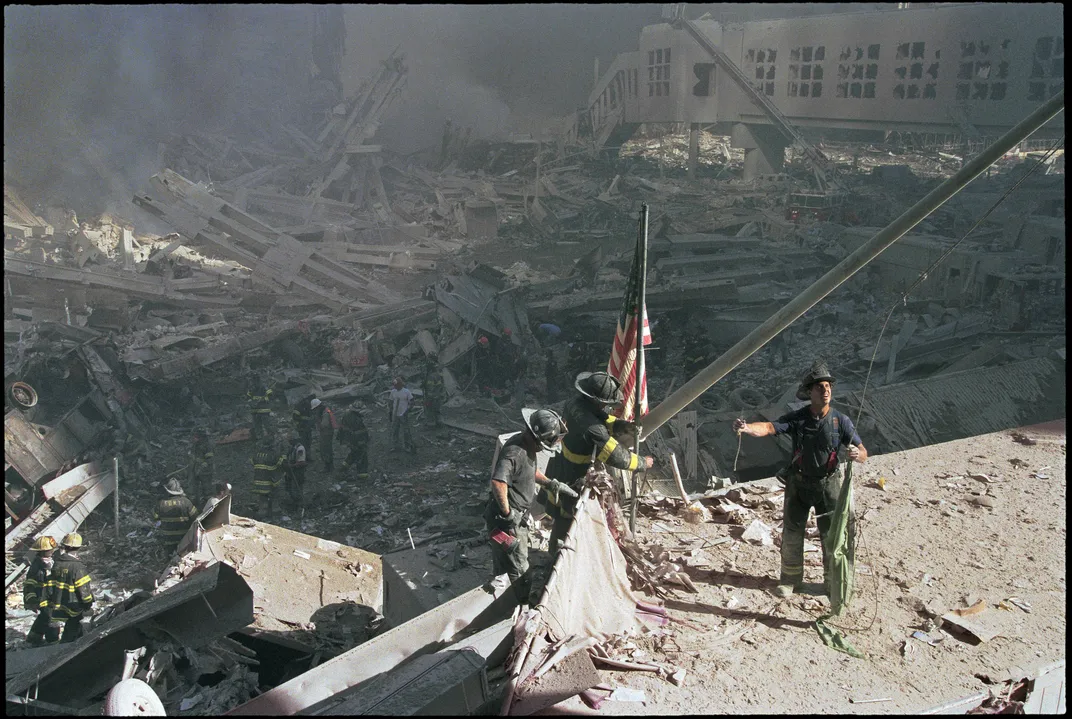
The firefighters didn’t know they were being photographed. But at least three journalists managed to get the moment on camera. Lori Grinker, on assignment for People magazine, and Ricky Flores of the Journal-News (Westchester County, New York) both shot from above, jostling for space in the window of a gutted building. The New Jersey-based Bergen Record’s Thomas E. Franklin aimed from below and zoomed in with a telephoto lens.
Of the three perspectives, just one—Franklin’s—became world-famous. His paper sent the image out on the Associated Press wire shortly after midnight, and soon it was everywhere: on posters, all over the Internet, hung in parks and people’s homes. The New York Post ran it on the cover with the lyrics to the Star-Spangled Banner, and more publications soon followed suit.
The shot eventually made Franklin a Pulitzer finalist. He also earned a trip to the White House, where he and President George W. Bush posed with McWilliams, Eisengrein and Johnson next to a commemorative stamp with their photo. (The stamp would go on to raise $10.5 million for first responders and their families.)
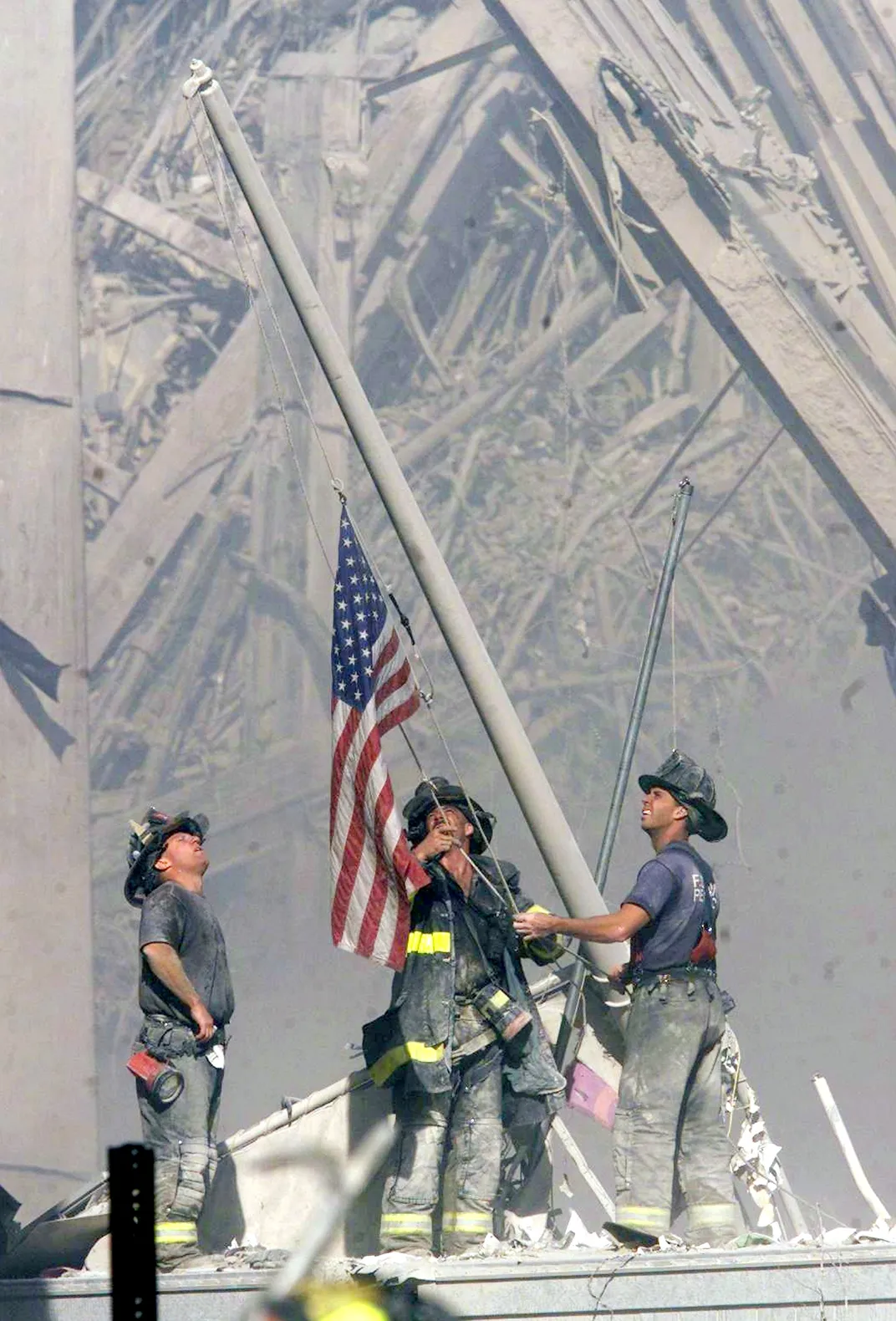
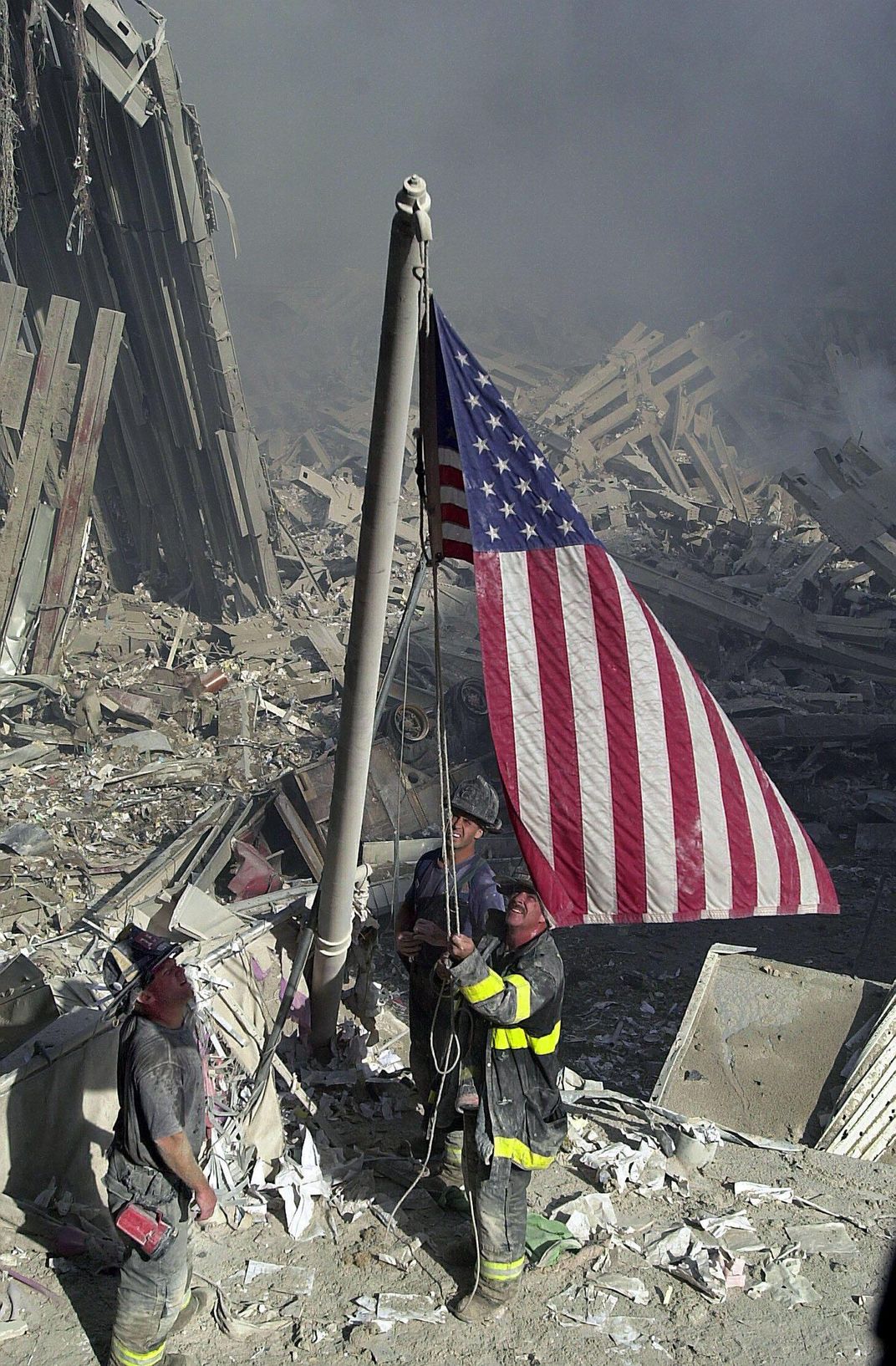
By the end of the week, Franklin’s shot was on its way to becoming “the most widely reproduced news picture of the new century,” writes journalist David Friend in Watching the World Change: the Stories Behind the Images of 9/11. It remains one of the rare uplifting images that emerged from the attacks, in which 19 men killed 2,977 people in New York, Arlington and Pennsylvania, injured more than 6,000 and caused lasting trauma to millions. As the stars and stripes rise, the three firefighters look upward with expressions of grim perseverance.
Few people know about the other images. Like Franklin, Flores captured the scene on a digital camera and framed it vertically, cropped close to the action, with the destruction behind flattened by dust and perspective.
But Grinker, shooting on film, captured a dramatic horizontal shot (seen at the top of this article) that reveals the firefighters at work in front of a tableau of rubble. Twenty years after the events of 9/11 and the U.S.-led “War on Terror” that followed, Grinker’s ominous photo imbues the iconic moment with a landscape of emotions—and more complexity—than her peers’.
“I think actually, in hindsight, Lori got the best photograph overall,” Flores says, “because she got scope.”
***
In the chaos and horror of that morning, Grinker almost missed her shot. An itinerant freelancer who traveled often, she had just moved into a temporary place in the Williamsburg neighborhood of Brooklyn. Her belongings were still in boxes. She was on her way to a doctor’s appointment—she had just wrapped chemotherapy and radiation to treat non-Hodgkin’s lymphoma a few months prior—when her landlady urged her to look at the television.
“She’s like, ‘Call your husband,’” Grinker recalls. “And of course, I call my agent.”
She sprinted out the door and across the Williamsburg Bridge with her Canon and a bit of Kodachrome film. Once, she considered going back for her sneakers—she had on a pair of black sandals—but decided against it. “I would have probably missed all of this,” if she had gone back, she adds.
In fact, all three photographers were lucky to arrive at the scene when they did. (They weren’t all acquainted with one another at the time, but since 9/11, Grinker, Flores and Franklin have become good friends as well as colleagues.) Franklin had happened to be in his newspaper’s office for an early meeting. After the planes hit, he photographed the towers’ collapse from across the Hudson before talking his way onto a boat headed for Manhattan.
Flores, a Bronx native, had just dropped his children off at school in Westchester when he got a call from his wife. He set off immediately, driving as far as he could before getting stopped by police barricades, and then slipped his car behind a news truck to make his way to Ground Zero.
As he approached, Flores was struck by the sight of cars burning, and the look on firefighters’ faces as they staggered away from the scene. He noted the amount of paperwork that had fallen from the towers, including letterheads from the company where his wife worked—Blue Cross Blue Shield. She had been at a funeral that morning in Long Island. Otherwise, she might have gone into work at one of the towers, like she typically did once or twice per week, he says.
Grinker, meanwhile, made her way through crowds of crying people, stopping every so often to let someone use her cellphone. Short on film, she relied on borrowed rolls from other photographers. She snapped photos selectively as she went: a shot of discarded shoes covered in gray ash, a traffic light hanging by a thread, firefighters lifting somebody’s remains.

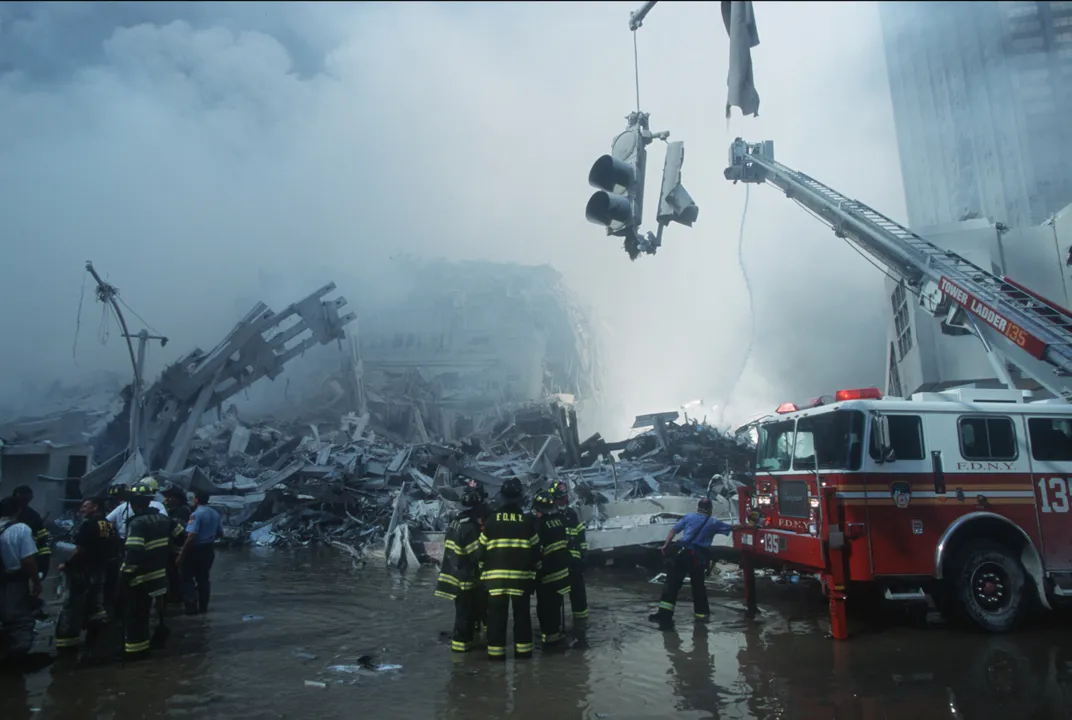
She had made her way to a triage site, where first responders were attempting to regroup after a long day of search-and-rescue. Climbing up a broken-down escalator, she looked out of the shattered windows of a building that had once faced the towers.
“I had like, 19 frames left on that one roll of film… when I saw them unfurling this flag, taking down the flagpole,” Grinker recalls. “I just remember that feeling that I get… that I knew this was something important. I get really nervous, my hands start to shake, my body starts to shake.”
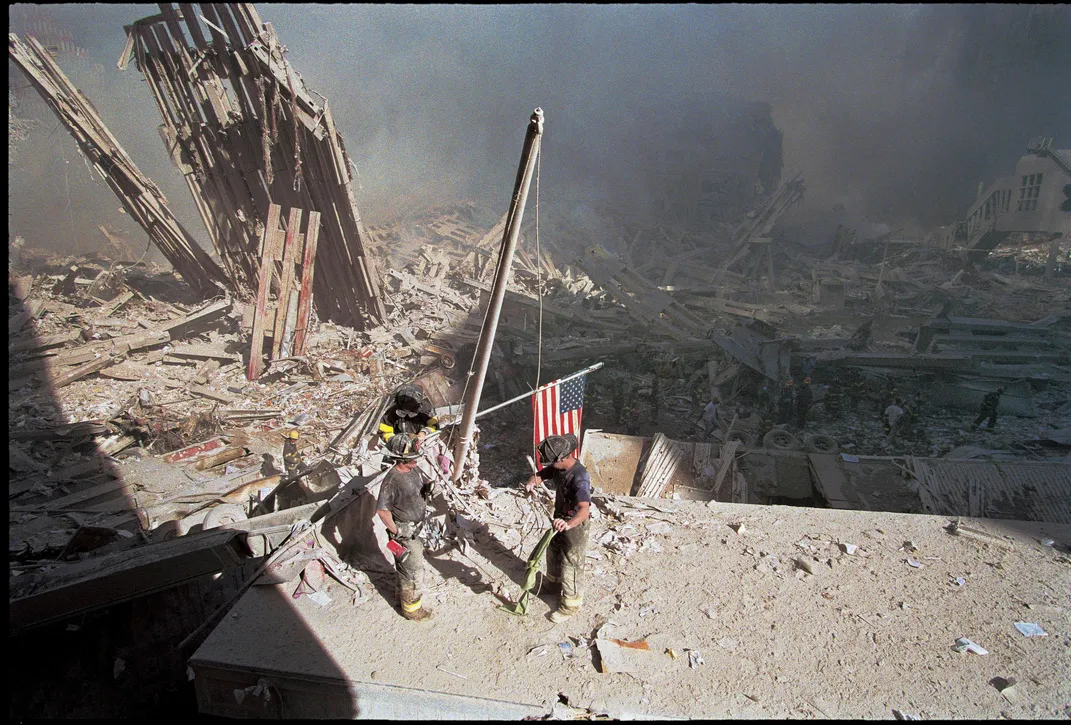
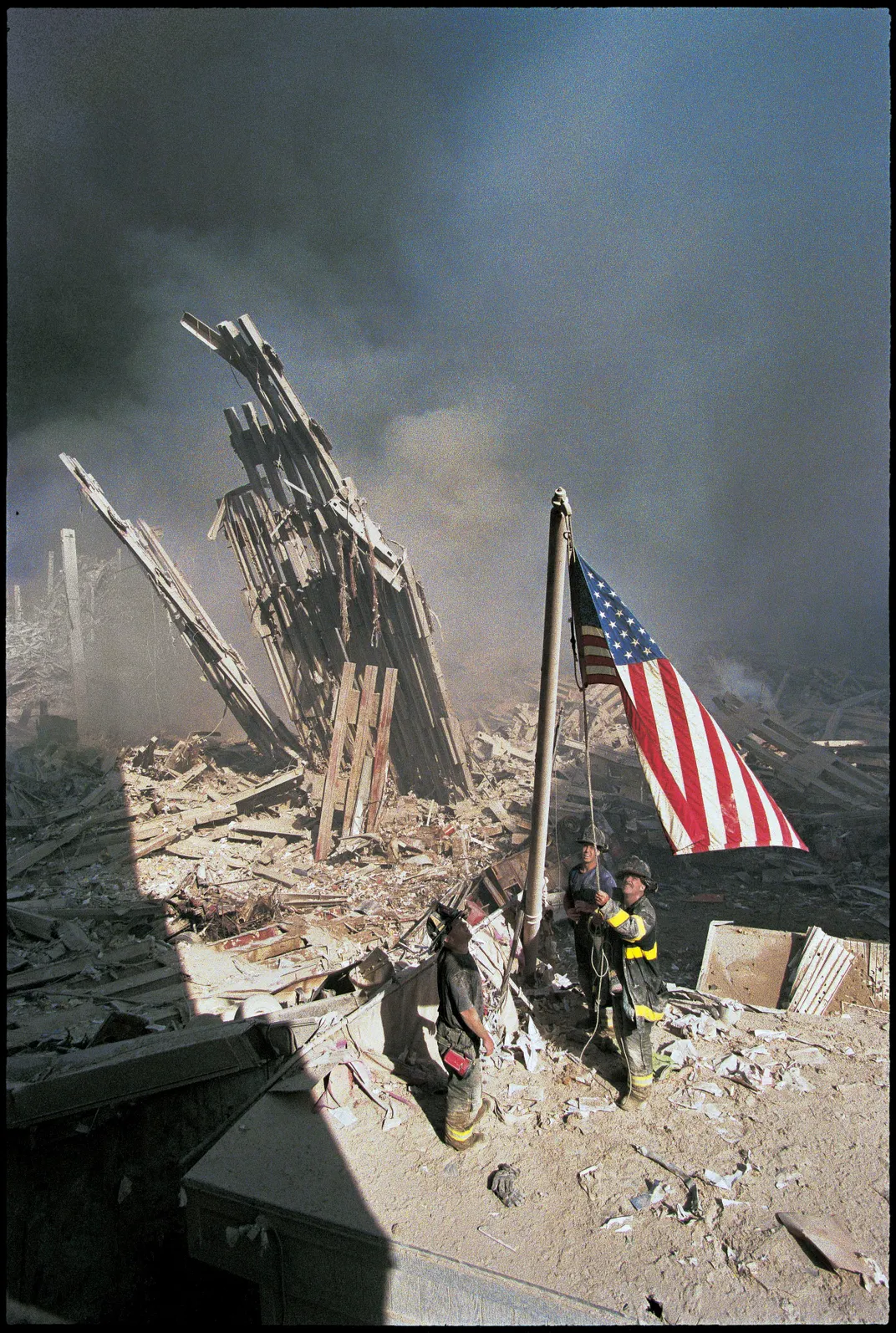
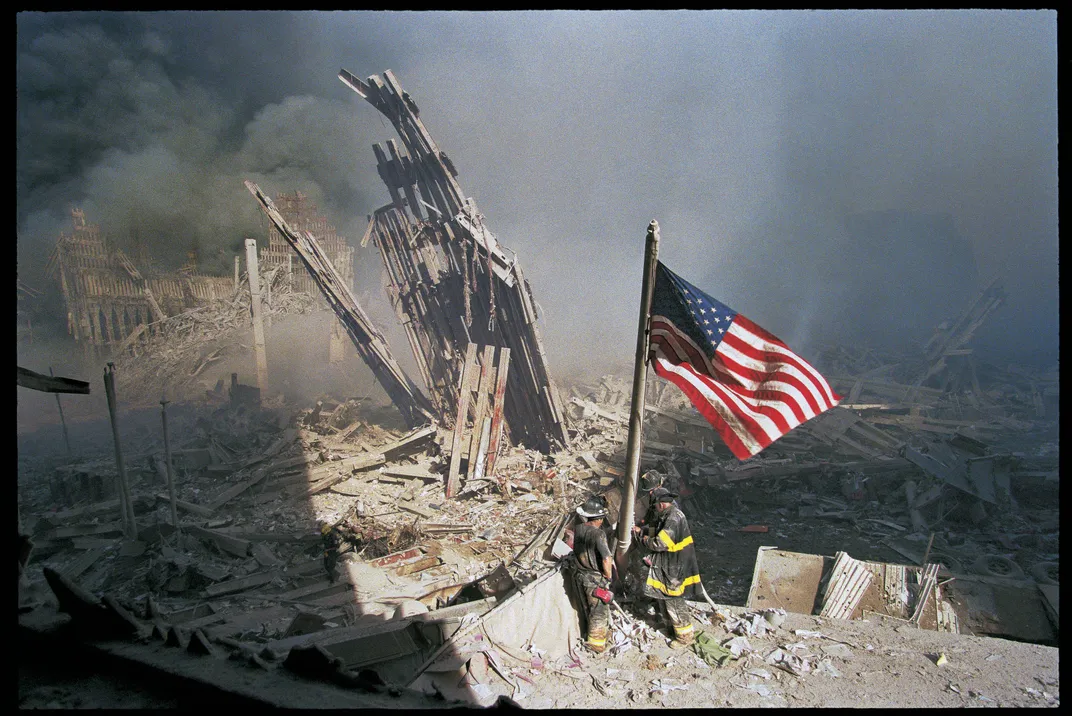
McWilliams, Eisengrein and Johnson did what they had planned to do with little fanfare, and Grinker, Flores and Franklin got their shots. Almost immediately after, workers began to yell at anyone nearby to evacuate the area: Tower 7, the 47-story building that had been burning for hours nearby, was about to fall.
The three photographers dispersed and hurried to make their deadlines. Franklin sprinted and caught a ride with a woman who had narrowly escaped the south tower, eventually filing his photos from a laptop in a hotel lobby in Secaucus, New Jersey. Flores drove back to White Plains, New York, to file at the office, before heading home, where his wife hosed the ash off his clothes before he walked into the house.
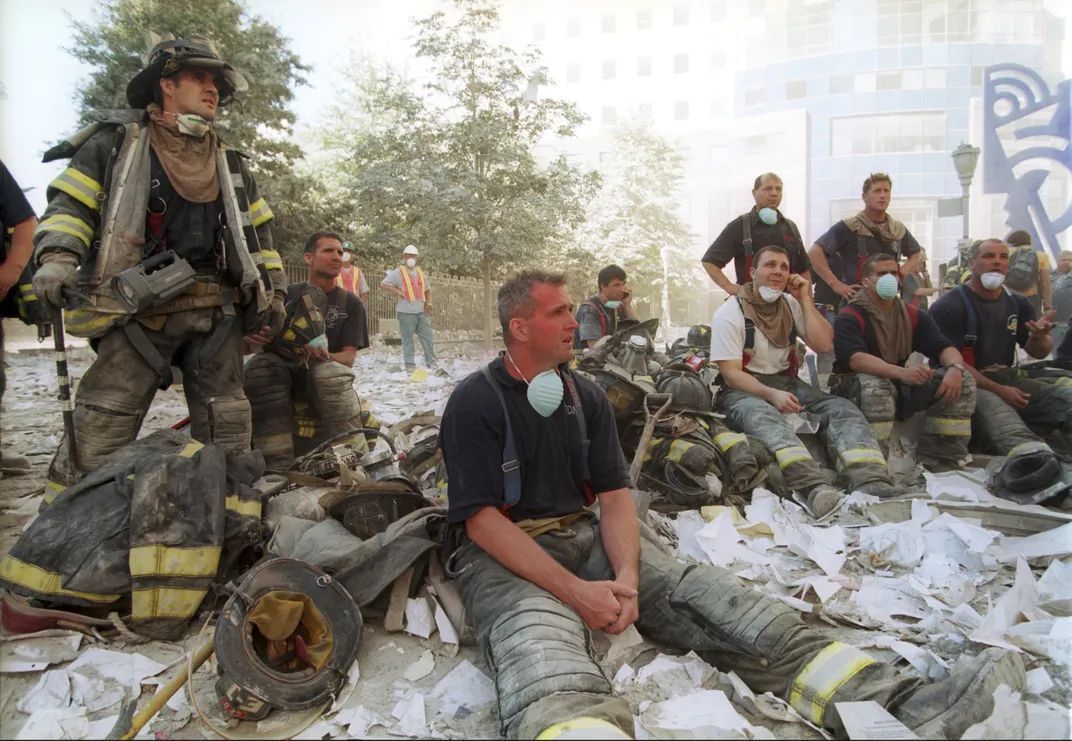
Grinker took the first working subway she could find, in the West Village, to get to Midtown and drop her film off at the Time and Life Building by 7 p.m. Everyone on the train stared at her: she was covered in thick white dust. At the office, she wiped it off in the photo lab with paper towels. Someone gave her some food—the first thing she’d eaten all day besides a banana.
Emerging into the clear night air of Rockefeller Plaza from the subway was surreal, Grinker recalls. “It was like coming up from hell.” It was only later that evening—at home or in their offices, leaning over computer screens with colleagues—that the photographers began to process what they had witnessed.
In the early 2000s, digital cameras would outsell their film counterparts for the first time in history. This proliferation of easy-to-use cameras—including some attached to mobile phones—meant that 9/11 became one of the “most photographed” disasters of all time, writes art historian Thomas Stubblefield in 9/11 and the Visual Culture of Disaster.
Yet in the visual record of the attacks, few popular images depicted death up close, in all its messiness and tragedy, the scholar notes. (Even photographer Richard Drew’s famous, and controversial, image of the Falling Man is minimalistic and “strangely beautiful,” Stubblefield says.)
In part, Stubblefield attributes this phenomenon to the unprecedented nature of the September 11 attacks. As Americans attempted to reckon with the unimaginable, they sought out photographs that offered a clear message about resilience. Franklin’s shot of the three men, conducting a patriotic ritual amid loss, offered reassurance to millions. “I still get phone calls, e-mails, messages to this day, telling me how much the photograph means to them,” says Franklin.
Whereas Franklin’s shot is compact and immediate, Grinker’s version takes longer to digest. In her horizontal image, firefighters raise the American flag on the right, while a slant of yellow light cuts through the scene and catches a ghostly swirl of smoke. Another first responder can be spotted in the shadows, indicating that the search for the missing and dead was still ongoing, and would continue.
“[Grinker’s image] is much more complicated, and it doesn’t necessarily sanitize the disaster” Stubblefield says. “The human figures are kind of dwarfed by what looks like a post-apocalyptic landscape.” He compares it to a 19th-century Romantic landscape painting, where the artist attempted to convey the sublime, overwhelming sense of being in nature.
Grinker’s photo also communicates something about the inexplicable. As Flores comments, her photo succeeds in depicting the scale of the tragedy—the firefighters were navigating hills of debris stacked 10 or 12 stories high, he says. “The wreckage almost overwhelms the scene in a way,” Stubblefield adds.
People often liken Franklin’s photo to Joe Rosenthal’s 1945 image, Raising the Flag on Iwo Jima. Franklin understands the comparison, though he considers the visual parallels “purely coincidental rather than anything by design.”
Yet the two images both share an undeniable link to an American war, albeit with different outcomes: Rosenthal’s with the Allied victory in World War II, and Franklin’s with the prolonged “War on Terror.” Within weeks of the attacks, coalition forces led by the United States invaded Afghanistan, launching a devastating 20-year-long conflict. Researchers at Brown University estimate that the post-9/11 wars, including those in Afghanistan and Iraq, have killed more than 929,000 people in the last two decades, including 387,00 civilians, and displaced 38 million more. After the U.S.’ defeat and withdrawal from the country this year, and the Taliban’s near-immediate takeover of major cities, the number of displaced Afghans will continue to rise, the United Nations warns.
As journalist Friend reports in Watching the World Change, in 2002, the U.S. military took a flag they mistakenly believed to be the one in Franklin’s photograph to the Arabian Sea, where it was carried as the “battle flag” aboard the U.S.S. Theodore Roosevelt. Friend also reports that soldiers in Afghanistan used the photo as a rallying symbol, painting it on the side of bombs and leaving the image behind as a “calling card” after raids.
“To many of those looking for potent symbols—as grist in the argument for expanding the fight against terror, to Iraq and elsewhere—the photo provided a pictorial validation that firefighter and terror fighter were kindred combatants in a single, seamless war,” Friend writes.
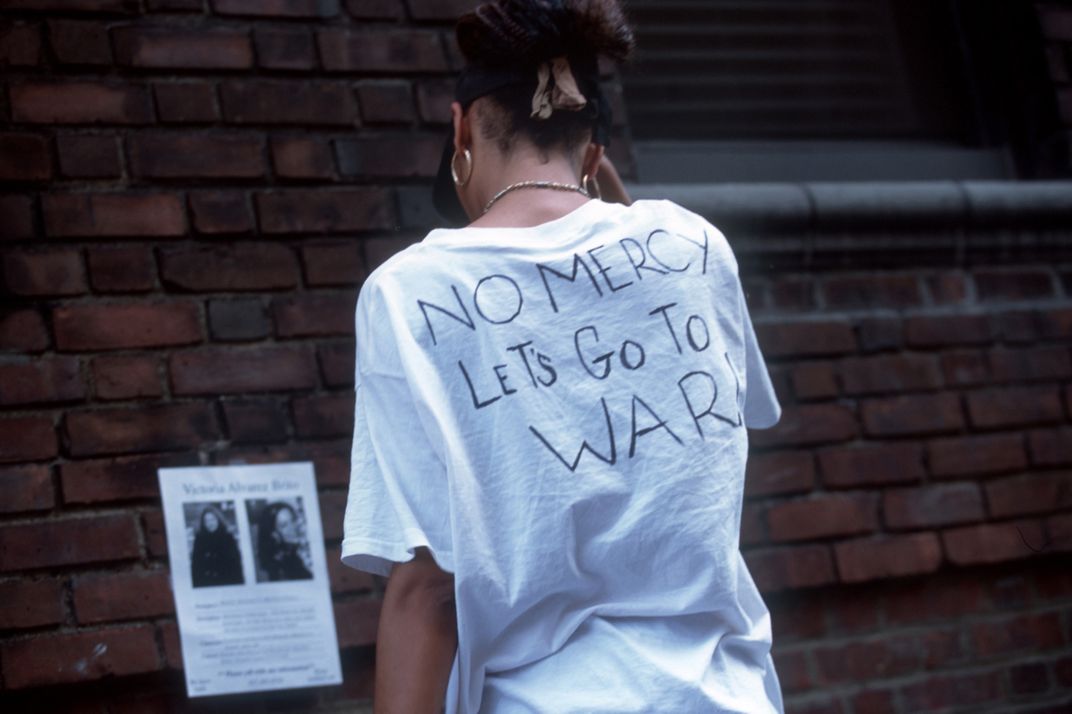
The clear-cut symbolism of Franklin’s image, in other words, was adopted by members of the military and the public as symbolic of fighting back. “In hindsight, it’s hard not to also read [Franklin’s photo] as a beginning of a response that itself is very violent,” Stubblefield adds.
Franklin’s image tells the story of a single moment on a terrible day. Twenty years later, Flores looks at Grinker’s darker, foreboding image, on the other hand, and thinks of the danger that was yet to come. “There’s this whole generation that grew up … with the consequences of a 20-year war,” he says. “It also set off this series of tragic events. The concept is so big, it’s hard to get your head around it.”
Grinker had one assignment on 9/11: to document the worst attack on domestic soil in American history. In the years after, she took on many other jobs. In 2003, Grinker was embedded on the hospital ship U.S.N.S. Comfort, where she made portraits of wounded Americans and injured Iraqi civilians at the onset of the Iraq War. She later traveled to Amman, Jordan, to report on the lives of Iraqi refugee families. Some of these poignant portraits made their way into her 2005 book, Afterwar: Veterans from a World in Conflict, a 15-year-long project that captures the “human cost of war” in the last century across 30 countries, from El Salvador to Vietnam, Pakistan, Spain, China, Russia, Syria, Afghanistan and Iraq.
“It can be easy to put the last story out of your mind when you move on to other projects,” Grinker says. But the events of 9/11 “carried through” her work in a sense, she adds, because she went on to document atrocities committed across the world.
Millions today, both in the U.S. and abroad, live with the fallout from 9/11, though fewer people hold memories of the day itself. “But it’s one of those things about history, being in the middle of something that will be talked about pretty much forever … [the event] becomes distant, becomes unfamiliar,” Flores says.
He adds, “But for those of us who lived it, it’s always fresh. It’s always raw.”
/https://tf-cmsv2-smithsonianmag-media.s3.amazonaws.com/filer/30/35/3035e1f6-67de-4a83-8ada-0f9ce8ae4b1e/gr0109-flagframe34a.jpg)
/https://tf-cmsv2-smithsonianmag-media.s3.amazonaws.com/accounts/headshot/nora.png)

